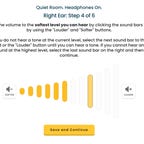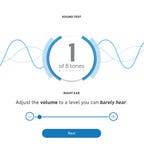The Best Online Hearing Tests of 2024
Measure your hearing health from the comfort of your home with these top hearing tests.
Our Picks
Hearing loss is surprisingly common, but the majority of people who could benefit from treatment have never gotten it. According to the National Institute on Deafness and Other Communication Disorders, less than 30% of US adults aged 70 or older with hearing loss have ever used a hearing aid. That number is even lower for adults aged 20 to 69 -- at 16%.
While the only way to diagnose hearing loss is to go to an audiologist for a professional exam, online hearing tests are an easy and fairly accurate way to initially gauge the situation from the comfort of your home.
There are a few common types of online hearing tests, including a pure-tone test, which evaluates how well you can hear sounds of different frequencies, and a speech-in-noise test, which evaluates how well you can hear spoken words above background noises. To help you determine which home hearing tests are worth taking, we tried 20 tests and narrowed them down to our absolute favorites. For best results, take the test with a high-quality pair of earbuds or headphones in the quietest area you can find. And for more on hearing health, check out the best over-the-counter hearing aids you can buy.
Best overall online hearing test
The Mimi hearing test app is our top pick overall because it offers multiple test types, is very easy to use and doesn't require any email sign-up. The results are more informative than other free tests, and you can go back and access them on an ongoing basis (they're saved for you in the app).
Best online hearing tests of 2024
Cost: Free
Test length: About 7 minutes
Type: Pure-tone and "masked threshold"
The Mimi hearing test comes in the form of an app that you can download to your phone or laptop. You don't have to sign up, and it's free -- just input some basic info, and you can access detailed results that include an audiogram and a comparison of each ear.
Unlike most other online tests, this one offers two test options: the first is a regular pure-tone test, and the second is similar to a speech-in-noise test but uses tones instead of speech. Mimi calls the latter a "masked threshold" test. The app measures whether you're in a quiet enough area to get accurate results, and it can pair with your Apple AirPods to calibrate (and if you find that you have hearing loss, it can work with your AirPods to make adjustments accordingly). It works best with headphones it can pair with, including the AirPods and some Sennheiser models, but can still be used with whatever you have.
Pros:
Highly intuitive
Multiple test options
Detailed results
No sign-up required
Cons:
Works best with Apple or Sennheiser headphones
Only available via app
Best hearing test for ease of use
MDHearing
Cost: Free
Test length: About 8 minutes
Type: Pure-tone
MDHearing's online hearing test is a pure-tone test, which looks at how well you can hear various tones of different frequencies. You adjust the volume of each tone until it's as low as possible while still being audible, then move on to the next one. The test's interface was more intuitive than some other online tests that use a similar format. It requires an email sign-up, but you don't have to take lengthy surveys (as many hearing aid brands' online tests require), and I didn't get any spam emails after taking the test.
The results of this test are detailed enough to be informative, yet easy to understand and not too overwhelming. They include an audiogram along with a guide to interpreting it, and there's a phone number to text or call for follow-up care. For an easy, quick look at your hearing health, this test does the trick.
Pros:
Simple
Easy to use
Informative results
Cons:
Requires email sign-up
Most helpful results
Soundly
Cost: Free
Test length: About 5 minutes
Type: Pure-tone
One of the challenges with online hearing tests is that home equipment isn't standardized -- your headphone quality, volume, background noise and so on can all affect the accuracy of your results. Many tests have ways of accounting for this, however. In Soundly's case, the test has you rub your hands together in front of your headphones to calibrate the volume of your headphones to the test's volume. The rest of the process consists of a standard pure-tone test in which you mark the lowest tone of each frequency that you can hear, on a set of sliders.
Soundly's results are nice and detailed and include an audiogram, explanations of each type of frequency and a video with an audiologist who explains how to interpret the test.
Audiograms can be confusing at first glance, so having both a written and video explanation is super helpful. This test requires an email sign-up and a brief survey at the start, but aside from the results, I didn't get any pesky marketing emails after taking the test.
Pros:
Sound calibration step
Easy to use
Detailed results with video
Cons:
Email sign-up required
Best hearing test for realistic everyday sounds
Amplifon
Cost: Free
Test length: About 3 minutes
Type: Speech-in-noise
Speech-in-noise tests determine how well you can hear speech alongside background noise, which is an important ability for everyday use. Many online speech-in-noise tests just have a voice reciting numbers or words over fuzzy white background noise. But Amplifon's test mimics real life: You'll have to figure out what people are saying at the orchestra, at a busy cafe, on a loud city street and more. The test takes just a few minutes.
Speech-in-noise tests don't test your hearing at different frequencies, so you won't get those types of detailed results — but they can be helpful for seeing how hearing loss could affect your life on a day-to-day basis. Amplifon's results tell you whether you have signs of hearing loss, how severe it is if so and what you can do next. Since Amplifon itself is a hearing care platform, there's also a link to request an appointment.
Pros:
Realistic and intuitive interface
Quick
No email sign-up required
Cons:
Results not as detailed
Best all-in-one hearing test
Starkey
Cost: Free
Test length: About 8 minutes
Type: True-tone and speech-in-noise
If you'd like the convenience of taking both a true-tone and speech-in-noise test at once, Starkey's online test does one after the other: First, you go through eight tones and mark the lowest volume that you can hear. Then you listen to words over background noise, and choose the correct words from a multiple-choice list (the words are all quite similar, so you have to listen closely).
The results are relatively simple -- there aren't any audiograms or charts. Instead the test tells you whether hearing loss was detected and what next steps you can take, including a link to find a professional hearing care provider.
Pros:
Two-in-one test
Easy to take
No email sign-up required
Cons:
Less detailed results
Factors to consider when choosing an online hearing test
- Cost: Is the test free, or does it cost money? Most online hearing tests do not require payment, unlike going to a professional.
- Time: How long does the test take to complete? Depending on your needs, you may want a quick 3-minute evaluation or a longer and more in-depth one.
- Follow-up steps: Will the test direct you on the next steps to take, or connect you with care based on your results? Most online hearing tests are affiliated with a retailer, brand or provider of some kind, so follow-up care is easy to find.
- Email Requirement: Does the test require you to input your email? If you feel like you're ready to shop for hearing aids or make an appointment, putting in your contact information for follow-up may actually be ideal. But if you're still in the browsing stage, you may not want to be bothered by it.
How we evaluate online hearing tests
We tried a total of 20 hearing tests from Jabra, Eargo, Phonak, Lexie, Costco and many other brands and retailers. Ultimately, most of the tests are usable and helpful to some extent -- but the ones we selected stood out in these areas.
- User experience: Was it easy to figure out the test's steps and understand the results? Something as simple as a bar graph or a button can make the experience so much more intuitive, which is especially important for people who aren't so tech savvy.
- Type: We looked at various types of tests, including true-tone and speech-in-noise, which can be helpful for different purposes and offer different types of results.
- Accuracy: It goes without saying that any test is only as useful as it is accurate. We prioritized tests that calibrate your headphones and that make sure you're in a quiet area to avoid skewing the results. Tests with clear instructions were also ranked higher.
- Sign-Up requirements: We considered whether an email sign-up was required, and if so, whether the company sent many follow-up emails, texts or phone calls afterward. Many of these tests are run by hearing aid brands or retailers, which will use the test as an opportunity to market to you. They're especially likely to do this if your results indicate that you could benefit from a hearing aid, but there's a fine line between helpful follow-up and spam.
Online hearing test vs. in-office hearing tests
Online hearing tests are a useful starting point to see whether you may have hearing loss. They're convenient and easy to use. But your results could be skewed if you don't follow every instruction, including calibrating your volume properly. Moreover, online hearing tests aren't as comprehensive as in-office hearing tests, and they can't diagnose the type or origin of your hearing loss. Audiologists have expertise and better tools, and they work in sound-treated rooms with professional equipment, per Healthy Hearing. That's why, even if your online test doesn't detect any issues, if you're experiencing any issues with your hearing or ears, it's worth going in for an in-person exam.
Online tests typically consist of just one or two of the following test types:
- Pure-tone, which involves listening to tones of different frequencies
- Speech-in-noise or background noise, which entails listening for a specific sound over background noise
- Speech audiometry, which tests for how well you can hear spoken audio at different volumes
An in-office hearing exam can include all of the above test types and more. These include (but aren't limited to):
- Bone conduction testing, which tests specific parts of the ear for issues such as fluid blockage
- Tympanometry, which tests how well your eardrum moves
- Otoacoustic emissions test, which looks at your inner ear function
- Physical examination of the ear's structures
While online hearing tests are usually free, in-office hearing exams may come at a cost. But if you have health insurance, Medicare or Medicaid, annual hearing tests are likely covered. Otherwise, the cost will vary by the practitioner or location.






